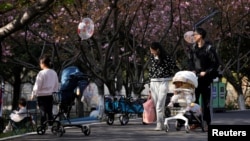On January 17, China’s National Bureau of Statistics published the latest number on the country’s population demographics.
The agency said the total number of people in China dropped by 2.08 million, compared with the population decline of 850,000 in 2022, when the country experienced its first negative population growth.
Meanwhile, China’s birth rate is now 6.39 per thousand people, a record low, while the death rate is 7.87 per thousand people.
Commenting on the news, Yin Sun, whose blue-checked X profile describes him as a Paris, France-based financial analyst, wrote that the two-year population decline is “a blessing” for China — mirroring the official Beijing narrative.
“To be honest, it’s a blessing if China’s population starts decreasing. With the modernization of China’s economy advancing toward fully automated technologies, it means a bigger pie for a smaller amount of people. The GDP per capita will therefore increase drastically.”
That is unsubstantiated.
The metaphorical pie in economics refers to the Gross Domestic Product, or GDP — the total value of goods and services produced. As the economy grows and the GDP increases, the pie gets bigger.
With negative population growth and more retirees, China, like many Western countries, might soon face a shrinking pie.
On the other hand, a robust innovation-focused strategy may result in China’s economy overcoming the challenges of a shrinking and aging population.
One-child policy leads to fewer babies
China saw birth rates fall for a decade after Beijing imposed the controversial one-child policy — a program to curb the country’s population growth by limiting most Chinese families to one child each.
The program started in 1979 and ended in 2016, resulting in a sustained low fertility rate. The World Bank’s chronological graph shows that China’s fertility rate fell from 7.5 births per woman in 1963 to 1.2 in 2021. By comparison, the world’s overall fertility rates for the same period fell from 5.3 births per woman to 2.3.
Meanwhile, the replacement fertility rate, which is the level of fertility at which a population exactly replaces itself from one generation to the next, is 2.1 births per woman.
A 2.1 fertility rate ensures “replacement of the woman and her partner, with another 0.1 children per woman to counteract infant mortality,” the Organization for Economic Cooperation and Development, or OECD, explained.
As a result of the one-child policy, China’s fertility rate was well below 2 children per woman for more than three decades.
At the same time, according to the Beijing-based YuWa Population Research Institute, the average cost of raising a child to the age of 18 in China stood at 485,000 yuan ($76,629) for a first child in 2019, almost seven times China’s per capita GDP that year ($10,144). The financial burden has many families thinking twice before adding members to their family.
The balance between old and young
In addition to the impact of the one-child policy, China has one of the fastest-growing aging populations in the world due to longer life expectancy and sustained low fertility rates.
China’s population aged 60 and over hit 296.97 million in 2023, roughly 21.1% of its total population. China’s National Health Commission expects that number will rise to more than 400 million by 2035, representing 30% of the population.
Roughly 300 million Chinese currently aged 50 to 60 are set to leave the workforce over the next decade.
Meanwhile, youth unemployment skyrocketed to more than 20% last year amid slowing economic growth.
The combination of more retirees and a shrinking working-age population means fewer people have to support a larger share of the population, putting pressure on Beijing’s health care and pension programs.
Tomoyuki Fukumoto, a professor at Osaka University of Economics, predicted in comments to Nikkei Asia that “the decline in the working-age population is likely to reduce China’s growth by around 1 percentage point annually from 2035 to 2050.”
There is, however, a silver lining. UBS, a Switzerland-based multinational financial company, said in an analysis that to overcome the aging and shrinking population challenges, China will have to adopt technologies such as robotics and AI and boost vocational education.
China’s long-term growth “radical plan” to recalibrate its economy has a positive outlook with its “tech-savvy population, focus on high tech industries and investment in innovation,” UBS said in a May 2023 report.
The Chinese government has made innovation a priority, providing subsidies and incentives to industries such as semiconductor, electric vehicles and AI robotics. “Smart manufacturing, combining digitally driven increased automation and data analytics to improve manufacturing performance and productivity, will play a key role facilitating the holistic nature of China’s output upgrade,” UBS analysts argued.
Another factor is that China is developing a silver economy. On January 15, China’s State Council unveiled 26 guidelines to promote the “silver economy,” to address the needs of the aging population. Some experts point out that the aging population could also be a strong force for domestic consumption.









